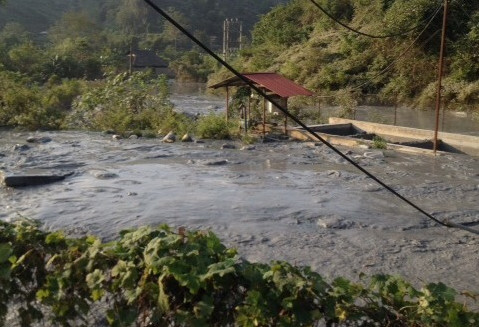To what extent is lead sludge spilled into dangerous rivers?
The breakdown of the reservoir in Cao Bang caused hundreds of thousands of cubic meters of water and lead and zinc sludge to spill into the environment, flowing into Gam river, so how are people using this water source affected?
Responding to PV, Associate Prof. Dr. Tran Hong Con, a member of the Department of Chemistry, University of Natural Sciences, Hanoi National University, said that lead is a soft, light gray color, found in nature as ore like sulfide. lead (galen). Lead melted at 327 degrees Celsius, boiled at 1,515 degrees Celsius, but at about 550-600 degrees Celsius, lead evaporated and when exposed to air it turned into lead oxide, very toxic. Lead and their compounds are all very toxic, the more soluble it is, the more toxic it is. The degree of danger of lead depends on their types of existence.
As for the incident in Cao Bang, Associate Professor Tran Hong Con said: "If it is a mineral mining company, it is not worrisome because at this time lead is in the form of lead sulfide . This form is not soluble in water so it is possible to do Water pollution is unlikely, but it is dangerous to use other chemicals to make lead concentrate with higher content, depending on what chemical and how long it takes to work. If it is only water and sulfide sludge, then that zinc will not affect the concentration of lead in the water. "

A large amount of lead sludge spilled into the river after the breakdown of the reservoir in Cao Bang.(Photo: VNA).
However, the expert also said that in the long run, much of the mud moving away will accumulate in the soil and mud, making the amount of lead in the form of sulfide high. At this time, they will first affect bottom-feeding animals such as snails, mussels, mussels, oysters, worms at the bottom. Then, through the food chain, they will affect people. In addition, through the process of underground transformation, air, they are also capable of converting into soluble forms and affect health. It is a long-term impact, not immediately causing body toxicity. Therefore, it is necessary to monitor to see how much the impact is.
When is lead particularly dangerous?
Associate Professor Tran Hong Con recommends that lead, if existed in a soluble form, is very dangerous because they enter the water, people who eat it will be poisoned. And lead sulfide is mineral in nature, even rain and wind do not melt, much less toxic.
Soluble lead forms are mainly used in chemical production plants, especially in manufacturing detonators, military factories. In daily life, lead oxide has been used a lot in orange medicine for children. When eating into the stomach will melt poisoning.
"Lead is a very toxic heavy metal, especially in very high levels of bone accumulation. They lose the ability to produce red blood cells that cause anemia, paleness, yellowing and death.
In acute poisoning, they cause anuria, damage to the kidneys, liver, and death. Immediate lead poisoning may not be dangerous but has a long-term impact , " said PGS Con.
Currently in Vietnam, lead poisoning is included in the list of covered occupational diseases . Lead and lead compounds are found in workers who work in many lead and dust environments at high concentrations above the permissible limit (above 0.00001 mg / l).
How to troubleshoot tank breakdown
Regarding this, PGS Con said that the current remedy after the lead waste breakage incident in Cao Bang is mainly mechanical method.
"Spilled lead sulfide will settle to the bottom and cannot follow long-distance flow because it is very heavy. However, it is necessary to check whether the tank contains the chemicals after recruiting, depending on the production process. When it happened, it is best for people to avoid using surrounding water , but not too worried because if only lead sulfide is not worrisome by They are insoluble in water, can use clean vacuum , " Assoc Con added.
- Broken tanks, hundreds of thousands of lead waste sludge flow into the river
- Industrial waste sludge fertilizing plants: Dangerous!
- How is the cup contaminated with lead?
- The river has been subject to death from ancient people
- How do countries in the world handle dredging dredging sea ports?
- Brick made of sludge
- Top 10 most dangerous substances on the planet
- Rivers are infected with antibiotics
- Producing concrete from ... industrial sludge
- Causes of lead poisoning and latent mercury at home
- Common misconceptions about lead in lipstick
- Common diseases of lead poisoning
 Is the magnetic North Pole shift dangerous to humanity?
Is the magnetic North Pole shift dangerous to humanity? Washington legalizes the recycling of human bodies into fertilizer
Washington legalizes the recycling of human bodies into fertilizer Lightning stone - the mysterious guest
Lightning stone - the mysterious guest Stunned by the mysterious sunset, strange appearance
Stunned by the mysterious sunset, strange appearance An invention that has been praised for decades turns into a disaster
An invention that has been praised for decades turns into a disaster  Decoding the cause of Beethoven's death
Decoding the cause of Beethoven's death  World's oldest skin whitening cream found in China
World's oldest skin whitening cream found in China  The persistent 'battle' of a scientist in the journey to eliminate leaded gasoline globally
The persistent 'battle' of a scientist in the journey to eliminate leaded gasoline globally  Lead poisoning from car smoke reduces IQ of half of the US population
Lead poisoning from car smoke reduces IQ of half of the US population  How dangerous is lead drinking water?
How dangerous is lead drinking water? 